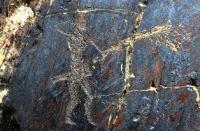Вы здесь
Petroglyphs of Siypantash.

Tours to cave drawing of Uzbekistan.
“...it seemed a part of her life, to step from the ancient to the modern, back and forth. She felt rather sorry for those who knew only one and not the other. It was better, she thought, to be able to select from the whole menu of human achievements than to be bound within one narrow range”
Orson Scott Card.
Photos petroglyphs of Uzbekistan.
The site is located in the south-western spurs of the Zerafshan Range, 40km north-west of Shahrisyabz, in the upper Kuruksay valley, on the northern outskirts of the village of the same name, opposite the village school. It is 820m above sea level.
The site was discovered and surveyed for the first time in 2001 by the Kashkadarya Archeological Expedition from NSU (Tashkent) and the History and Archeology Institutes of the NAS of the RUz led by R.Kh. Suleymanov, who photographed selected surfaces with images.
Provisionally, the researchers dated the site to a period from the Mesolithic to the Bronze Age (Suleymanov 2002: 71). Some petroglyphs in open rock shelters may date to modern times. Description of the Site. Siypantash (“Slippery Stone”) is a group of rock ledges located on the right, eastern slope of the Kuruksay Gorge, noted for its outcroppings of granite and diorite.
Ledges of rock formed by wind erosion have relatively smooth dome-shaped surfaces towering over an inclined surface of the rock 1 - 1.5m high and more. Two large ledges of rock stand out: the first and main one is 8m long and 3 - 5m wide and the second adjacent to it is 4m long and 2m wide.
The images were engraved and painted on a rough rock surface covered with calc-sinter, sometimes dark-gray, reddish-brown, or yellowish-brown. The paints are made from mineral pigments with black, yellow, and reddish-brown shades.
The repertoire of images on the main ledge mainly consists of geometric figures: single rightangled and other crosses, a foot-shaped sign, rows of short straight or crossing lines, a circle with a cross inside and others.
An outline figure of an ox with arched horns is the centerpiece among other barely visible outlined images. In several cases, some painted images overlap and apparently date to different periods. Some animals are carved into a reddish layer of rock varnish in the lower part of the roof near the “floor” surface.
The upper part of the second ledge includes a small oval niche, decorated with prints of 10-12 miniature palms painted red. A group of images includes complex shapes such as an oval with crossing lines, two circles with crosses inside connected to a line and others.
All those images are in the same red. The ground surface under the main ledge, which is inclined at 40°, is heavily polished. It is a slippery pathway used by pilgrims as well as adult and child campers to slide down the longitudinal axis of the ledge of rock.
Large oval or circular cup-holes can be seen on the slightly sloping floor under the third ledge located lower than the ledges of rocks with images; 6 - 7 cup-holes about 10 cm deep with traces of smoothing on their edges are arranged in two rows.
The location and shape of the ledge only allows access from the south-eastern side where quaint wind-eroded rocks look like an arched entrance. Carved sketchy animals differ from adjacent modern drawings; 20 - 25m away from the ledge on the surface of one of the lower rocks, they are apparently dated to the Late Middle Ages or modern times.
The site is located on the territory of a modern village next to residential and utility buildings; nevertheless, the condition of the ledges and surrounding rocks with images is on the whole satisfactory, despite some visible damage (flaking, paint on some images).
Siypantash is registered as a site of local importance, but boundaries and protection zones of the site have not been defined nor physical protection provided by the government-authorized agencies. However Siypantash is a place for rites, respect and reverence on the part of the local population; sliding down the inclined smooth rock under the central ledge has a ceremonial and magical significance.
Authority:
Muhiddin Khujanazarov.
Photos by
Alexander Petrov.







